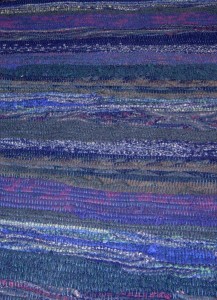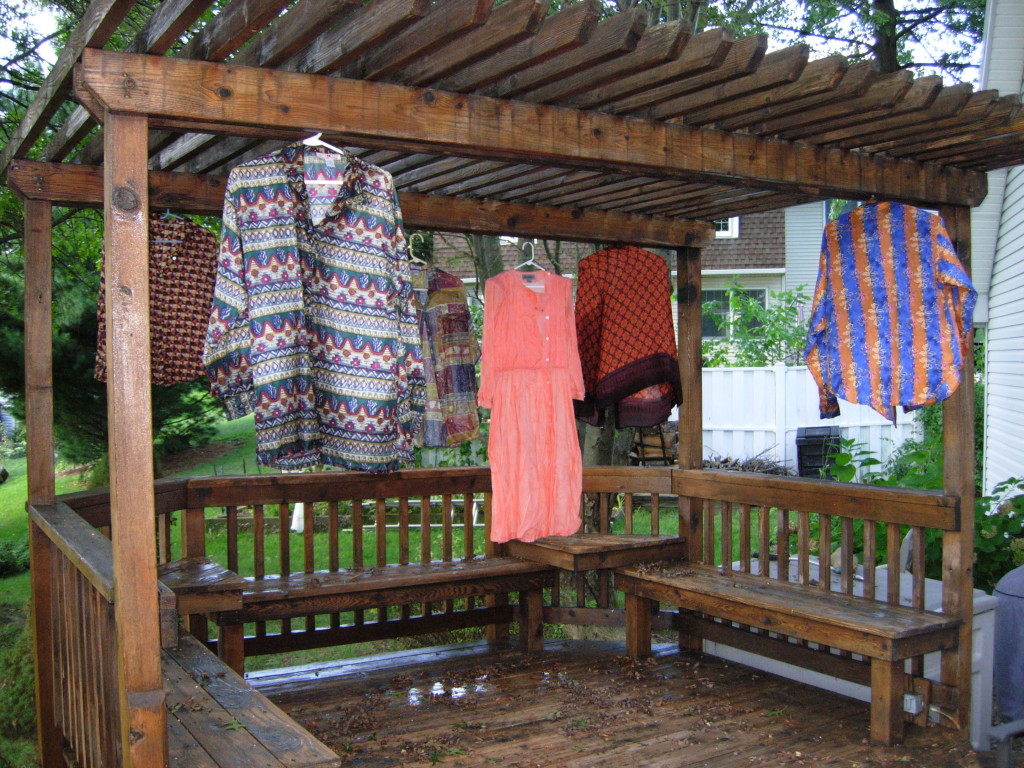Western Sakiori
Western Sakiori is the marriage of historical Japanese sakiori techniques and traditions with modern North American materials and aesthetics.

My first rug made from felted sweaters.
For both environmental and economic reasons, I was always very interested in the recycling and re-using aspects of weaving. I loved being able to tear apart worn-out sheets and make beautiful rag rugs, or old towels to make durable bath mats. I found it fascinating that, in bygone days, weavers would recover the weft material from rag rugs whose warp threads had worn out, and re-weave them into another rug. I experimented with using sock loops (from actual old socks) and felted sweaters as weft, with great success. Because some of the sweaters I picked up at thrift shops seemed too nice to felt and cut up, I started learning how to unravel sweaters for their yarn, and now do nearly all of my knitting and much of my (non-rag) weaving from recycled yarns. It was in regularly scouring thrift shops for sweaters to recycle and for t-shirts or sheets for rag rugs that I came to notice all of the silk dresses, shirts, pantsuits, etc. lurking in the aisles. It seemed a shame that there were so many of such unpleasant pattern or construction that they were destined for, at best, the rag bundles that most thrift shops sell for a few coins per pound to clothing recyclers, who ship much of it to third-world countries. It is wasteful, for one thing, to ship our castoffs thousands of miles away before they are used. It also seems sad to me that so many silkworms gave their lives for this cloth that had been rendered unusable by the poor choices made during the design and manufacturing process. I have found silk track suits, short sets, out-of-style dresses, and remarkably ugly prints, mostly on thin, cheap Chinese silks that don’t have much wear left in them.

Silkworms gave their lives for this?!?
I didn’t start buying silks right away, but they stayed on my mind until I was looking through one of my old issues of Handwoven and saw the article by Johanna Erickson (March/April 1995, p.56-57) in which she provides instructions for a scarf made from rayon fabric and a novelty yarn warp. From there, I continued to research rag weaving and discovered that in sakiori, there already existed a long-standing tradition of making new garments from rags. In typically Japanese fashion, the garments are made of the rectangular pieces that come off the loom, with little or no cutting. This is seen as protecting the integrity and strength of the cloth, as well as preventing the waste of materials or effort. It also means the garment can be easily disassembled into its components and re-made into something different, as needed.
When I decided to start experimenting with silk rags, I chose to honor the principles of sakiori by choosing discarded garments that were readily available in my geographic location. I chose silk because it is our ‘best’ fabric available as rag, and sought to create a fabric that would serve the purposes of someone dressing for life today. Specifically, because it was silk, the resulting fabric should be supple and have the sheen and rich colors we associate with that material. I chose to make items of clothing the Japanese way, with little or no waste.
In future posts I will reveal my first completed garment, followed by an illustrated guide of my sampling process through the actual construction of the garment. Now and then, I’ll instead post about current events in weaving, the textile industry, or other fiber arts, as well as classes or workshops I attend and/or teach. I welcome your comments and suggestions for news and topics to cover in the blog.
